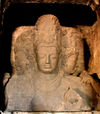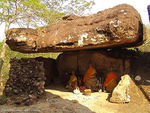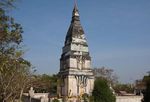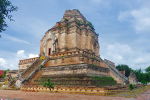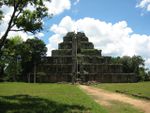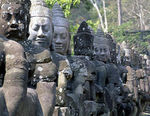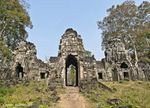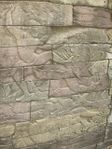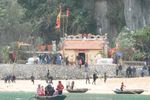List of UNESCO Hindu World Heritage Sites
From Hindupedia, the Hindu Encyclopedia
From the long-spanning history of Hinduism, people's creativity has created several sites of wonder which are revered even today. Many of these works of marvel have been recognized internationally as a splendid to humanity and cultures.
UNESCO Sites[edit]
South Asia[edit]
India[edit]
| No. | Name | Image | Region | Period | UNESCO data | Description |
|---|---|---|---|---|---|---|
| 1 | Mahabodhi Temple Complex at Bodh Gaya, Bihar | 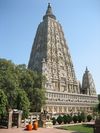
|
Bihar, India | 3rd century BC, 5th and 6th century AD and 19th century | 1056 rev; 2002; i,ii, iii, iv, vi | Mahabodhi Temple Complex at Bodh Gaya (Buddha Gaya), spread over an area of 4.86ha was inscribed in the UNESCO World Heritage List i as a unique property of cultural and archaeological importance. The first temple was built by Emperor Ashoka in the 3rd century BC (260 BC) around the Bodhi Tree Ficus religiosa (to the west of the temple). However, the temples seen now are dated between 5th and 6th centuries AD. The structures have been built in bricks. Revered and sanctified as the place where Siddhartha Gautama Buddha was enlightened in 531 BC at age 35, and then propagated his divine knowledge of Buddhism to the world, it has been the ultimate temple for reverential worship, over the last several centuries, by Buddhists of all denominations, from all over the world who visit on pilgrimage. The main temple is 50 m in height, built in Indian architectural style, dated between 5th and 6th centuries, and it is the oldest temple in the Indian sub-continent built during the "Golden Age" of Indian culture credited to the Gupta period. Sculpted balustrades of the Ashokan times (3rd century BC) are preserved in the Archaeological Museum located within the temple complex.[1][2] |
| 2 | Group of Monuments at Hampi | 
|
Ballari district, Karnataka, India | 14th and 16th centuries | 241 ; 1986; (i)(iii)(iv) | The Group of Monuments at Hampi comprise a sombre but ostentatious Hampi town, on the banks of the river Tungabhadra in Karnataka. Hampi subsumes the ruins of Vijayanagara, which was the former capital of the powerful Vijayanagara Empire. Dravidian temples and palaces abound in Hampi. These won the admiration of travellers between the 14th and 16th centuries. Hampi, as an important Hindu religious centre, has the Virupaksha Temple (different from Pattadakal's Virupaksha Temple) and several other monuments, which are part of the cultural heritage site inscribed under category (i), (iii) and (iv) in the UNESCO World Heritage List.[3][4] |
| 3 | Group of Monuments at Pattadakal | 
|
Bagalkot District, Karnataka, India | 8th century | 239 ; 1987; (iii)(iv) | The Group of monuments in Pattadakal designated under UNESCO World Heritage List, in 1987, cover a remarkable series of nine Hindu temples, as well as a Jain sanctuary in northern Karnataka. In this group of temples, the Virupaksha Temple, built in B.C. 740 by Queen Lokamahadevi to commemorate her husband's (King Vikramaditya II) victory over the Pallava kings from the south, is considered the most outstanding architectural edifice. This is different from the Virupaksha Temple at Hampi. These are a remarkable combination of temples built by the Chalukya Dynasty in the 6th to 8th century at Aihole, Badami and Pattadakal, the latter city was known as the "Crown Rubies". The temples represent a remarkable fusion of the architectural features of northern (Nagara) and southern (dravida) India. Pattadakal is considered a Hindu holy city and within the heritage complex are eight temples dedicated to Shiva, a ninth Śaivite sanctuary called the Papanatha Temple and a Jain Narayana temple.[5][6] |
| 4 | Buddhist Monuments at Sanchi, Madhya Pradesh | 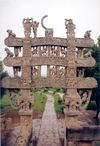
|
Madhya Pradesh, India | 2nd and 1st centuries BC to the 12th century AD | 524; 1989; (i)(ii)(iii)(iv)(vi) | Buddhist Monuments at Sanchi, located 45km from Bhopal in the Indian state of Madhya Pradesh are a group of Buddhist monuments dated between 200 BC and 100 BC. The site, however, has been conjectured to have been developed in the 3rd century BC, when Emperor Ashoka of the Mauryan Empire ruled. The principal monument is Stupa 1 dated to the 2nd century and 1st century BC. These Buddhist sanctuaries were active Buddhist religious monuments, which flourished till the 12th century. The sanctuary has a plethora of monolithic pillars, palaces, temples and monasteries in different status of preservation. It was inscribed as a World Heritage Site by UNESCO on January 24, 1989 for its unique cultural importance. It was discovered only in 1818 in a deserted state of preservation. Archaeological excavations undertaken thereafter revealed 50 unique monuments.[7][8][9] |
| 5 | Rock Shelters of Bhimbetka, Madhya Pradesh | 
|
Madhya Pradesh, India | 30,000 years | 925; 2003; (iii) (v) | Rock Shelters of Bhimbetka described in the UNESCO Inscription as "the site complex … a magnificent repository of rock paintings within natural rock shelters" is located in the foothills of the Vindhya range of hills in the Central Indian state of Madhya Pradesh. It is spread in sandstone formations extending over an area of 1893 ha with a buffer zone 10280ha. The rock shelters, discovered only in 1957, comprise a group of "five clusters of rock shelters" with paintings that are inferred to date from the "Mesolithic period right through to the Historical period", with the 21 villages surrounding them reflecting the traditions displayed in the rock paintings. The unique rock art has been discovered in 400 painted shelters spread over an area of 1,892 ha amidst dense forest with high diversity of flora and fauna, with some of the shelters dated from 100,000 BC (Late Acheulian) to 1000 AD. It was inscribed as a World Heritage Site by UNESCO in 2003 as a unique cultural property representing a convergence displayed in the art form between the people and the landscape with links to the hunting gathering economy of the past.[8][10][11] |
| 6 | Khajuraho Group of Monuments, Madhya Pradesh | 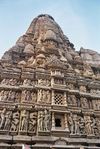
|
Madhya Pradesh, India | 950 AD to 1050 AD | 240; 1986; (i) (iii) | Khajuraho Group of Monuments attributed to the Chandela dynasty which, under sovereignty of Gurjar Pratihars reached its glory. The ensemble of monuments that have survived belong to the Hindu and Jain Religious practices with striking fusion of sculpture and architecture; the best example of this outstanding feature is seen in the Kandariya Temple. Of the 85 temples built, only 22 temples have survived in an area of 6 km2, which represents the Chandela period of the 10th century. Located in the Indian state of Madhya Pradesh, it was inscribed by UNESCO as a World Heritage Site, a cultural property on October 15, 1982 for its unique original artistic creation and proof of the Chandela Culture that existed prior to the Muslim invasion of India in the early 12th century.[12][13] |
| 7 | Ajanta Caves | 
|
Maharashtra, India | 2nd century BC to the 6th century | 242; 1983; i, ii, iii, vi | Ajanta Caves listed under UNESCO World Heritage as a cultural heritage site, are Buddhist caves that were built in two phases, the first phase was from the 2nd century BC. In the second phase, further additions were made during the 5th and 6th centuries AD of the Gupta period. The caves depict richly decorated paintings, frescoes, which are reminiscent of the Sigiriya paintings in Sri Lanka and sculptures. As a whole, there are 31 rock-cut cave monuments which are unique representations of the religious art of Buddhism.[14][15][16] |
| 8 | Ellora Caves | 
|
Maharashtra, India | 600 to 1000 AD | 243; 1983; (i)(iii)(vi) | Ellora Caves also known as Ellora Complex are a cultural mix of religious arts of Buddhism, Hinduism and Jainism. These are 34 monasteries and temples sculpted contiguously into rock walls of a high basalt cliff, which are seen along a length of 2km. Dated to 600 to 1000 AD, they are a reflection of artistic creation of the ancient civilization of India. This cultural property has been inscribed under the UNESCO World Heritage List.[17][18] |
| 9 | Elephanta Caves | 
|
Maharashtra, India | 5th to 8th centuries | 244rev; 1987; (i)(iii) | The Elephanta Caves are a network of sculpted caves located on Elephanta Island, or Gharapuri (literally "the city of caves") in Mumbai Harbour, 10km to the east of the city of Mumbai. The island, located on an arm of the Arabian Sea, consists of two groups of caves — the first is a large group of five Hindu caves, the second, a smaller group of two Buddhist caves. The Hindu caves contain rock cut stone sculptures, representing the Shaiva Hindu sect, dedicated to the god Shiva. The rock-cut architecture of the caves is dated to between the 5th and 8th centuries, although the identity of the original builders is still a subject of debate. The caves are hewn from solid basalt rock. Renovated in the 1970s, the caves were designated an UNESCO World Heritage Site in 1987 to preserve the artwork.[19][20] |
| 10 | Sun Temple, Konârak | 
|
Puri District, Orissa, India | 13th-century | 246; 1984;(i)(iii)(vi) | Konark Sun Temple is a 13th-century Sun Temple (also known as the "Black Pagoda"), at Konark, in Orissa. Located on the east coast of the Bay of Bengal in the Mahanadi Delta, it is built in the form of the chariot of Surya (Arka), the sun god with 24 wheels, and is heavily decorated with symbolic stone carvings and led by a team of six horses. It was constructed from oxidizing weathered ferruginous sandstone by King Narasimhadeva I of the Eastern Ganga Dynasty. The temple is one of the most renowned temples in India and is a World Heritage Site inscribed in 1984 as cultural property under categories (i), (iii) and (vi).[21][22] |
| 11 | Great Living Chola Temples | 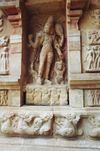
|
Brihadeeswarar temple, Gangaikonda Cholapuram, Tamil Nadu, India | 11th and 12th century | 250bis; 1987; (ii)(iii) | The Great Living Chola Temples, built by kings of the Chola Empire stretched over all of Tamil Nadu. This cultural heritage site includes three great temples of 11th and 12th centuries namely, the Brihadisvara Temple at Thanjavur, the Brihadisvara Temple at Gangaikondacholisvaram and the Airavatesvara Temple at Darasuram. The Temple of Gangaikondacholisvaram, built by Rajendra I, was completed in 1035. Its 53m vimana (sanctum tower) has recessed corners and a graceful upward curving movement, contrasting with the straight and severe tower at Thanjavur. The Airavatesvara temple complex, built by Rajaraja II, at Darasuram features a 24m vimana and a stone image of Shiva. The temples testify to the brilliant achievements of the Chola in architecture, sculpture, painting and bronze casting. The site was inscribed under UNESCO World Heritage List in 1987 as Cultural heritage under criteria (ii) and (iii).[23][24] |

|
Airavateshwarar Temple, Darasuram, Tamil Nadu, India | |||||
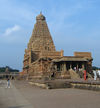
|
Brihadeeswarar Temple, Thanjavur, Tamil Nadu, India | |||||
| 12 | Group of Monuments at Mahabalipuram | 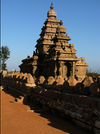
|
Mahabalipuram, Tamil Nadu, India | 7th and 8th centuries | 249; 1984; (i)(ii)(iii)(vi) | The Group of Monuments at Mahabalipuram, in Tamil Nadu, about 58 km from Chennai, were built by the Pallava kings in the 7th and 8th centuries. The town is said to have gained prominence under the rule of Mamalla. These monuments have been carved out of rock along the Coromandel coast. The temple town has approximately forty monuments, including the largest open-air bas-relief in the world. It was inscribed under the UNESCO World Heritage list in 1984 as a cultural heritage under categories (i)(ii)(iii)(vi). The monuments inscribed are the Ratha Temples: Temples in the form of chariots, Mandapas, 11 Cave sanctuaries covered with bas-reliefs, rock relief of Descent of the Ganges, which is the largest open air Rock relief also known as Arjuna's Penance or Bhagiratha's Penance.[25][26] |
| 13 | Rani ki vav (The Queen's Stepwell) |

|
Patan, Gujarat, India | 11th century AD[27] | 2014 | Rani ki vav (The Queen's Stepwell) at Patan, Gujarat, is a famous stepwell It is famous for its size and sculpture. The length of Rani ki Vav is more than 64m long, 20m wide & 27m deep and there are more than 500 sculptures of god. Most of the sculptures are in devotion to Vishnu, in the forms of Dus-Avatars Kalki, Rama, Mahisasurmardini, Narsinh, Vaman, Varahi and others representing their return to the world. Nagkanya, Yogini beautiful women – Apsara showcasing 16 different styles of make-up to look more attractive called Solah-shringar.[28][29] |
| 14 | Nalanda | 
|
Bihar, India | 5th to 12th centuries | 2016[30] | The Nalanda Mahavihara site is in the State of Bihar, in north-eastern India. It comprises the archaeological remains of a monastic and scholastic institution dating from the 3rd century BCE to the 13th century CE. It includes stupas, shrines, viharas (residential and educational buildings) and important art works in stucco, stone and metal. Nalanda stands out as the most ancient university of the Indian Subcontinent. It engaged in the organized transmission of knowledge over an uninterrupted period of 800 years. The historical development of the site testifies to the development of Buddhism into a religion and the flourishing of monastic and educational traditions. |
Sri Lanka[edit]
| No. | Name | Image | Region | Period | UNESCO data | Description |
|---|---|---|---|---|---|---|
| 1 | Temple of the Tooth at Kandy | 
|
Kandy, Sri Lanka | The Sri Dalada Maligawa or The Temple of the Sacred Tooth Relic is a temple in the city of Kandy in Sri Lanka. It was built within the royal palace complex which houses the tooth relic of the Buddha, a tooth, which is venerated by Buddhists. The relic has played an important role in the local politics since ancient times, it's believed that whoever holds the relic holds the governance of the country, which caused the ancient kings to protect it with great effort. Kandy was the capital of the Sinhalese Kings from 1592 to 1815, fortified by the terrain of the mountains and the difficult approach. The city is a world heritage site declared by UNESCO, in part due to the temple. | ||
| 2 | Sigiriya Complex at Sigiriya | 
|
Sigiriya, Sri Lanka | 477 – 495 CE by King Kasyapa. | The capital and the royal palace was abandoned after the king's death. It was used as a Buddhist monastery until the 14th century. | |
| 3 | Sacred City of Anuradhapura | 
|
Anuradhapura, Sri Lanka | 4th century BCE | ||
| 4 | Cave Temple Dambulla at Ibbankatuwa | 
|
Ibbankatuwa, Sri Lanka | 1st century BCE | Dambulla Cave temple (also known as the Golden Temple of Dambulla) is a world heritage site (1991) in Sri Lanka, situated in the central part of the country. This site is situated 148 km (92 mi) east of Colombo and 72 km (45 mi) north of Kandy. It is the largest and best-preserved cave temple complex in Sri Lanka. The rock towers 160 m (525 ft) over the surrounding plains.There are more than 80 documented caves in the surrounding. Major attractions are spread over 5 caves, which contain statues and paintings. This paintings and statues are related to Lord Buddha and his life. There are total of 153 Buddha statues, 3 statues of Sri Lankan kings and 4 statues of gods and goddesses. The later 4 include two statues of other gods, Vishnu and Ganesh. The murals, covers an area of 2,100 square meters. Depictions in the walls of the caves include Buddha's temptation by Mara (demon) and Buddha's first sermon. |
Bangladesh[edit]
| No. | Name | Image | Region | Period | UNESCO data | Description |
|---|---|---|---|---|---|---|
| 1 | Ruins of the Buddhist Vihara at Paharpur | 
|
Naogaon, Bangaldesh | 781–821 CE |
Nepal[edit]
| No. | Name | Image | Region | Period | UNESCO data | Description |
|---|---|---|---|---|---|---|
| 1 | Lumbini, the Birthplace of the Lord Buddha | 
|
Lumbini, Nepal |
Pakistan[edit]
| No. | Name | Image | Region | Period | UNESCO data | Description |
|---|---|---|---|---|---|---|
| 1 | The City of Taxila | 
|
Taxila, Pakistan | 5th century BCE to 1st century CE | 139; 1980; iii, vi | Taxila is an archaeological site located in the Rawalpindi District, 30 km northwest of Islamabad. The city dates back to the Gandhara period and contains the ruins of the Gandhāran city of Takṣaśilā which was an important Hindu and Buddhist centre, and is still considered a place of religious and historical sanctity in those traditions. |
| 2 | Buddhist Ruins of Takht-i-Bahi and Neighbouring City Remains at Sahr-i-Bahlol | 
|
Khyber Pakhtunkhwa, Pakistan | 1st century CE | 140; 1980; iv | Takht-i-Bahi, meaning spring throne, is a Buddhist monastic complex dating to the 1st century BC located on top of a 152 m high hill. The ruins are located about 16 km from Mardan and 80 km from Peshawar. Sahr-i-Bahlol is a small fortified city, dating from the same era, located near Takht-i-Bahi. The historical complex is a complete Buddhist monastery consisting of four main groups; the Court of Stupas, a monastic complex, a temple complex, and a tantric monastic complex. |
South East Asia[edit]
Cambodia[edit]
| No. | Name | Image | Location | Criteria | Area ha (acre) |
Year | Description | Refs |
|---|---|---|---|---|---|---|---|---|
| 1 | Angkor | 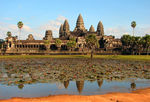
|
Angkor, Siem Reap Province, Cambodia | Cultural: (i), (ii), (iii), (iv) |
40000ha | 1992 | Angkor is one of the most important archaeological sites in South-East Asia. Stretching over some 400 km2, including forested area, Angkor Archaeological Park contains the magnificent remains of the different capitals of the Khmer Empire, from the 9th to the 15th century. They include the famous Temple of Angkor Wat and, at Angkor Thom, the Bayon Temple with its countless sculptural decorations. UNESCO has set up a wide-ranging programme to safeguard this symbolic site and its surroundings. The site was listed as endangered from its inscription in times of political instability following the civil war in the 1980s to 2004. | [31][32] [33] |
| 2 | Temple of Preah Vihear | 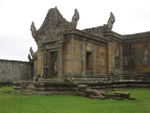
|
Temple of Preah Vihear, Preah Vihear Province, Cambodia | Cultural: (i) |
155ha; buffer zone 2643ha | 2008 | Situated on the edge of a plateau that dominates the plain of Cambodia, the Temple of Preah Vihear is dedicated to Shiva. The Temple is composed of a series of sanctuaries linked by a system of pavements and staircases over an 800 metre long axis and dates back to the first half of the 11th century AD. Nevertheless, its complex history can be traced to the 9th century, when the hermitage was founded. This site is particularly well preserved, mainly due to its remote location. The site is exceptional for the quality of its architecture, which is adapted to the natural environment and the religious function of the temple, as well as for the exceptional quality of its carved stone ornamentation. | [34] |
Indonesia[edit]
| No. | Name | Image | Location | Criteria | Area ha (acre) |
Year | Description | Refs |
|---|---|---|---|---|---|---|---|---|
| 1 | Borobudur Temple Compounds | 
|
Borobudur Temple Compounds, Magelang Regency, Central Java, Indonesia | Cultural: (i), (ii), (vi) |
1991 | This famous Buddhist temple, dating from the 8th and 9th centuries, is located in central Java. It was built in three tiers: a pyramidal base with five concentric square terraces, the trunk of a cone with three circular platforms and, at the top, a monumental stupa. The walls and balustrades are decorated with fine low reliefs, covering a total surface area of 2,500 m2. Around the circular platforms are 72 openwork stupas, each containing a statue of the Buddha. The monument was restored with UNESCO's help in the 1970s. | 592[35] | |
| 2 | Cultural Landscape of Bali Province: the Subak System as a Manifestation of the Tri Hita Karana Philosophy | 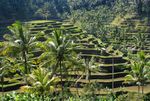
|
Cultural Landscape of Bali Province, Bali, Indonesia | Cultural: (ii), (iii), (v), (vi) |
19,520ha | 2012 | The cultural landscape of Bali consists of five rice terraces and their water temples that cover 19,500 ha. The temples are the focus of a cooperative water management system of canals and weirs, known as subak, that dates back to the 9th century. Included in the landscape is the 18th-century Royal Water Temple of Pura Taman Ayun, the largest and most impressive architectural edifice of its type on the island. The subak reflects the philosophical concept of Tri Hita Karana, which brings together the realms of the spirit, the human world and nature. This philosophy was born of the cultural exchange between Bali and India over the past 2,000 years and has shaped the landscape of Bali. The subak system of democratic and egalitarian farming practices has enabled the Balinese to become the most prolific rice growers in the archipelago despite the challenge of supporting a dense population. | 1194rev[36] |
| 3 | Prambanan Temple Compounds | 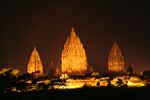
|
Prambanan Temple Compounds, Central Java, Indonesia | Cultural: (i), (iv) |
1991 | Built in the 10th century, this is the largest temple compound dedicated to Shiva in Indonesia. Rising above the centre of the last of these concentric squares are three temples decorated with reliefs illustrating the epic of the Ramayana, dedicated to the three great Hindu divinities (Shiva, Vishnu and Brahma) and three temples dedicated to the animals who serve them. | 642[37] |
Thailand[edit]
| No. | Site | Image | Location | Criteria | Area ha (acre) |
Year | Description | Refs |
|---|---|---|---|---|---|---|---|---|
| 1 | Historic City of Ayutthaya | 
|
Historic City of Ayutthaya, Ayutthaya province, Thailand | Cultural: (iii) |
289ha | 1991 | [38] | |
| 2 | Historic Town of Sukhothai and Associated Historic Towns | 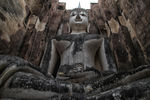 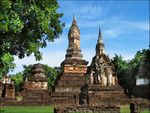 
|
Historic Town of Sukhothai and Associated Historic Towns, Sukhothai Province and Kamphaeng Phet Province, Thailand | Cultural: (i), (iii) |
11852ha | 1991 | [39] |
Tentative list[edit]
India[edit]
Apart from the sites inscribed on the World Heritage list, India has also maintained a list of tentative sites for recognition which has been submitted to UNESCO Committee for evaluation and acceptance. This procedure of prelisting is a prerequisite for the nominations for the World Heritage list to be accepted.[40][41]
| No. | Name | Image | Region | UNESCO data | Period | Description |
|---|---|---|---|---|---|---|
| 01 | Temples at Bishnupur | 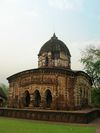
|
Bishnupur, West Bengal, India | 1998 | 1600-1758 AD | West Bengal is famous for its terracotta temples built in the 17th and 18th centuries and the balucheri sarees |
| 02 | Ancient Buddhist Site in Sarnath | 
|
Sarnath, Varanasi District, Uttar Pradesh, India | 1998 | 500 CE | Ancient Buddhist Site in Sarnath, Varanasi, Uttar Pradesh where Gautama Buddha first taught the Dharma, and where the Buddhist Sangha came into existence through the enlightenment of Kondanna. (1998) |
| 03 | Sri Harimandir Sahib (The "Golden Temple") |

|
Amritsar, Punjab, India | 2004 | August 1604 | Sri Harimandir Sahib (The "Golden Temple") in Amritsar, Punjab, is the holiest shrine in Sikhism |
| 04 | Ekamra Kshetra – The Temple City |   
|
Bhubaneswar, Odisha, India | 2014 | 3rd century BCE | |
| 05 | Sacred Ensembles of the Hoysala | 
|
Karnataka (Belur and Halebidu), India | 2014 | 1113–1268 AD | Group of 25 Jain and Hindu temples.[42][43][44][45] built in 12th and 13th century AD by Hoysala Emperors. |
| 06 | Monuments of Srirangapatna Island Town | 
|
Karnataka, India | 2014 | 9th-18th century | Group of structures including Ranganatha Swamy Temple, Tipu Sultan's palace, Tipu Sultan's Gumbaz, Garrison cemetery, Scott's Bungalow, Srirangapatna Fort, Bailey's Dungeon, Ranganathittu Bird Sanctuary. |
| 07 | The Glorious Kakatiya Temples and Gateways | 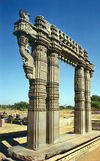 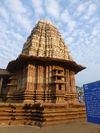 
|
Warangal, Telangana, India | 2014 | 1163 AD[46] | This is a collection of the Kakatiya era Gateways and Temples. They are Kakatiya Kala Thoranam, Warangal Fort, Ramappa Temple and Thousand Pillar Temple. |
| 08 | Sites of Satyagraha, India’s non-violent freedom movement | 
|
India | 2014 | Satyagraha loosely translated as "insistence on truth"[47] generally known as nonviolent resistance, was coined and developed by Mahatma Gandhi[48] for Indian independence movement. Satyagraha theory influenced Nelson Mandela's struggle in South Africa under apartheid, Martin Luther King, Jr.'s and James Bevel's campaigns during the Civil Rights Movement in the United States, and many other social justice and similar movements.[49][50] | |
| 09 | Sri Ranganathaswamy Temple, Srirangam | 
|
Srirangam, Tiruchirapalli, Tamil Nadu, India | 2014 | 10th century AD | |
| 10 | Dholavira: A Harappan City | 
|
Gujarat, India | 2014 | 2650 BCE | Ancient Dholavira, archaeological site in Kutch District contains ruins of ancient Indus Valley Civilization city, it is one of the largest Harappan archaeological sites.[51] |
| 11 | Evolution of Temple Architecture – Aihole-Badami-Pattadakal | 
|
Aihole, Badami and Pattadakal in Karnataka, India | 2015 | 450 A.D. | Cradle of Indian rock cut architecture |
| 12 | Jaipur |  
|
Jaipur, Rajasthan | 2015 | 18 November 1727 | India's historic city and capital city of state of Rajasthan- nominated for World Heritage City status. Famous for palaces and Forts. |
| 13 | Cold Desert Cultural Landscape of India |   
|
Ladakh, India | 2015 | Much of it being over an altitude of 3,000 m (9,800 ft).[52][53] | |
| 14 | River Island of Majuli | 
|
Brahmaputra River, Assam, India | 2004 | River Island of Majuli in midstream of the Brahmaputra River in Assam, it is the largest river island in the world.[54][55] This was the centre for Saint Sankaradeva of the Vaishnava Ekasarana sect. | |
| 15 | Silk Road Sites in India |   
|
Bihar, Jammu and Kashmir, Maharashtra, Puducherry, Punjab, Tamil Nadu and Uttar Pradesh in India | 2010 | Around 114 BC – 1450s | This is part of the extensive interconnected network of trade routes across the Asian continent connecting East, South, and Western Asia with the Mediterranean world, as well as North and Northeast Africa and Europe |
| 16 | Chilika Lake | 
|
Odisha, India | 2014 | It is the largest coastal lagoon in India and the second largest lagoon in the world.[56][57] It also contains the Konarak Sun Temple, built originally on the seashore a few hundred years ago. | |
| 17 | Chettinad, Village Clusters of the Tamil Merchants |  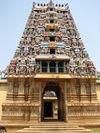
|
Chettinad, Tamil Nadu, India | 2014 | It is well-known for its temples. Originally built by early Tamil dynasties like the Cholas, the temples of Chettinad stand testimony to the spiritual beliefs of local people. Temples are built per Vaastu Shastras and Agamas as the Chettinad wealthy sponsored the buildings and the shilpis after the royal families declined. On the side note, traditional houses were also built per ancient text on architecture called Vaastu Shastras. | |
| 18 | Archaeological remains of Lothal | 
|
Gujarat, India | 2014 | 3700 BCE.[58] | It is one of the most prominent city of the ancient Indus valley civilisation, discovered in 1954, Lothal was excavated from 13 February 1955 to 19 May 1960 by the Archaeological Survey of India (ASI). Lothal's dock—the world's earliest known—connected the city to an ancient course of the Sabarmati river.).[59] |
| 19 | Ahmedabad |   
|
Gujarat, India | 2011 | 11th century | The historic and most important city of the state of Gujarat in India- nominated for World Heritage City status. Its Kankaria Lake and the Kirti Stambh at Hutheesing Temple is popular. |
Pakistan[edit]
| No. | Name | Image | Region | Category | Year submitted | Description | Reference |
|---|---|---|---|---|---|---|---|
| 1 | Katasraj Temple, Chakwal | 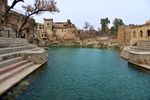
|
Punjab, Pakistan | Cultural | 2005 | The Katas Raj Temples near Chakwal in Punjab province of Pakistan are attributed to the eras of the Hindu Shahis (kings) dating from about 615-950 CE and are dedicated to Lord Shiva. As such they constitute one of the most important Hindu pilgrimage sites in Pakistan and are still in use to this day by members of the Hindu community both in the country and those who make the journey there every year from abroad. | [60] |
| 2 | Archaeological Site of Mehrgarh | 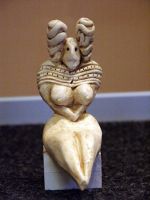
|
Balochistan, Pakistan | Cultural; iii, iv | 2004 | Mehrgar, is one of the most important Neolithic (7000 BCE to c. 2500 BCE) sites in archaeology. It is one of the earliest sites with evidence of farming and herding in South Asia. | [61] |
| 3 | Archaeological Site of Harappa | 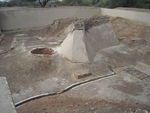
|
Punjab, Pakistan | Cultural; ii, iv | 2004 | Harappa is an archaeological site which is site of the ancient city contains the ruins of a Bronze Age fortified city, which was part of the Cemetery H culture and the Indus Valley Civilization, centered in Sindh and the Punjab. | [62] |
| 4 | Archaeological Site of Ranigat | 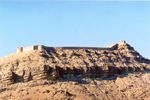
|
Khyber Pakhtunkhwa, Pakistan | Cultural; ii, iv | 2004 | The archaeological site of Ranigat remains of the region's largest Buddhist monastic complex reside. Structures on the site include stupas, monasteries, shrines, drainage networks, and other buildings. Ranigat is a 2500-year-old Buddhist archaeological site belonging to the Gandhara civilization and is a good evidence of the Buddhist past of the area. | [63] |
| 5 | Shahbazgarhi Rock Edicts | 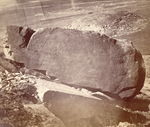
|
Khyber Pakhtunkhwa, Pakistan | Cultural; i, ii, vi | 2004 | Shahbazgarhi is the location of ancient rock-inscriptions that are cut into two large rock boulders and written in the Kharosthi script. They retain immense historical importance, as they appear to be the first examples of writing in South Asia. They were constructed during the 3rd Century BC, during the reign of Ashoka, the famous Mauryan emperor. | [64] |
| 6 | Mansehra Rock Edicts | 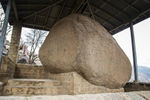
|
Khyber Pakhtunkhwa, Pakistan | Cultural; i, ii, vi | 2004 | Mansehra Rock Edicts are fourteen edicts of the Mauryan emperor Ashoka, inscribed on rocks in Mansehra. The edicts are cut into three boulders and date back to 3rd century BC and they are written in the ancient Indic script of Gandhara culture, Kharosthi. The edicts mention aspects of Ashoka’s dharma. | [65] |
| 7 | Port of Banbhore | 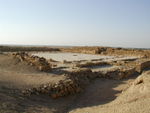
|
Sindh, Pakistan | Cultural; iv,v,vi | 2004 | Port of Banbhore is an ancient city dating to the 1st century BC, dates back to the Scytho-Parthian era and was later controlled by Muslims from 8th to 13th century after which it was abandoned. Remains of one of the earliest known mosques in the region dating back to 727 AD are still preserved in the city. | [66] Contemporary stone buildings from the three periods are also uncovered in the area including a palatial stone building with semi-circular shape, a Shiva temple from the Hindu period. |
Thailand[edit]
| No. | Name | Image | Location | Criteria | Area ha (acre) |
Year | Description | Refs |
|---|---|---|---|---|---|---|---|---|
| 1 | Phimai, its Cultural Route and the Associated Temples of Phanomroong and Muangtam | Angkor Roads, Buriram Province, Nakhon Ratchasima Province, Nakhon Ratchasima and Surin Provinces, Thailand | Cultural: (i), (ii), (iii), (iv), (vi) |
2004 | [67] | |||
| 2 | Wat Phra Mahathat Woramahawihan, Nakhon Si Thammarat | Phra Baromathat, Nakhon Si Thammarat Province, Thailand | Cultural: (i), (ii), (vi) |
137 ha | 2012 | [68] | ||
| 3 | Phuphrabat Historical Park | Udon Thani Province, Thailand | Cultural: (iii), (iv), (v), (vi) |
500 ha | 2004 | [69] | ||
| 4 | Monuments, Sites and Cultural Landscape of Chiang Mai, Capital of Lanna | Monuments, Sites and Cultural Landscape of Chiang Mai, Capital of Lanna, Chiang Mai Province, Thailand | Cultural: (i),(ii), (iii),(vi) |
- | 2015 | [70] |
Indonesia[edit]
| No. | Name | Image | Location | Criteria | Area ha (acre) |
Year | Description | Refs |
|---|---|---|---|---|---|---|---|---|
| 1 | Muara Takus Compound Site | 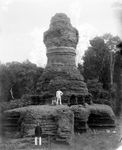
|
Muara Takus Compound Site, Kampar Regency, Riau , Indonesia | Cultural: (i), (iv), (vi) |
2009 | 5464[71] | ||
| 2 | Muarajambi Temple Compound | 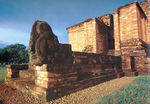 
|
Muarajambi Temple Compound, Muaro Jambi Regency, Jambi, Indonesia | Cultural: (ii), (iii), (iv) |
2062 ha | 2009 | 5464[72] | |
| 3 | Trowulan - Former Capital City of Majapahit Kingdom | 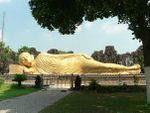 
|
Mojokerto Regency, East Java, Indonesia | Cultural: (i), (v) |
99 km2 | 2009 | 5466[73] | |
| 4 | The Old Town of Jakarta (Formerly old Batavia) and 4 Outlying Islands (Onrust, Kelor, Cipir dan Bidadari) |  
|
Jakarta, Indonesia | Cultural: (ii),(iii),(iv),(v) |
- | 2015 | This is the city of the famous Jin De Yuan Temple (Vihara Dharma Bhakti, the oldest Buddhist temple in Jakarta.) | 6010[74] |
| 5 | Semarang Old Town | 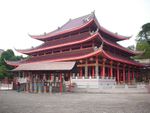
|
Central Java, Indonesia | Cultural: (ii),(iv) |
- | 2015 | 6011[75] |
Cambodia[edit]
| No. | Site | Image | Location | Criteria | Area ha (acre) |
Year | Description | Refs |
|---|---|---|---|---|---|---|---|---|
| 1 | Sambor Prei Kuk | 1992 | ||||||
| 2 | Koh Ker | 1992 | ||||||
| 3 | Phnom Kulen | 1992 | ||||||
| 4 | Angkor Borei and Phnom Da | 1992 | ||||||
| 5 | Oudong | 1992 | ||||||
| 6 | Beng Mealea | 1992 | ||||||
| 7 | Preah Khan Kompong Svay | 1992 | ||||||
| 8 | Banteay Chhmar | 1992 | ||||||
| 9 | Banteay Prey Nokor | 1992 |
Laos[edit]
| No. | Name | Image | Location | Criteria | Area ha (acre) |
Year | Description | Refs |
|---|---|---|---|---|---|---|---|---|
| 1 | Pha That Luang | 1992 |
Vietnam[edit]
| No. | Name | Image | Location | Criteria | Area ha (acre) |
Year | Description | Refs |
|---|---|---|---|---|---|---|---|---|
| 1 | Cat Tien National Park | 2006 | ||||||
| 2 | Cát Bà Island | 2011 |
Other nominated sites[edit]
Azerbaijan[edit]
| No. | Name | Image | Region | UNESCO data | Period | Description |
|---|---|---|---|---|---|---|
| 01 | Ateshgah of Baku Fire Temple at Baku | 
|
Baku, Azerbaijan | 17th and 18 centuries CE |
See also[edit]
References[edit]
- ↑ "Mahabodhi Temple Complex at Bodh Gaya". UNESCO. http://whc.unesco.org/en/list/1056. Retrieved on 2010-10-03.
- ↑ "Mahabodhi Temple (India) No.1056rev"
. UNESCO. http://whc.unesco.org/archive/advisory_body_evaluation/1056rev.pdf
. Retrieved on 2010-10-03.
- ↑ "Group of Monuments at Hampi". World Heritage: Unesco.org. http://whc.unesco.org/en/list/241. Retrieved on 2010-11-06.
- ↑ "Group of Monuments at Hampi"
(PDF). Unesco. http://whc.unesco.org/archive/advisory_body_evaluation/241.pdf
. Retrieved on 2010-11-06.
- ↑ "Group of Monuments at Pattadakal". World Heritage: Unesco.org. http://whc.unesco.org/en/list/239. Retrieved on 2010-11-06.
- ↑ "Group of Monuments at Pattadakal"
(PDF). Unesco. http://whc.unesco.org/archive/advisory_body_evaluation/239.pdf
. Retrieved on 2010-11-06.
- ↑ "Buddhist Monuments at Sanchi" (PDF). UNESCO. http://whc.unesco.org/en/list/524. Retrieved on 2010-10-02.
- ↑ 8.0 8.1 "List of World heritage in danger". UNESCO. http://whc.unesco.org/en/danger/. Retrieved on 2010-10-01.
- ↑ "Nomination to the World Heritage List"
(PDF). Unesco. http://whc.unesco.org/archive/advisory_body_evaluation/524.pdf
. Retrieved on 2010-10-02.
- ↑ "Buddhist Monuments at Sanchi" (PDF). UNESCO. http://whc.unesco.org/en/list/925. Retrieved on 2010-10-02.
- ↑ "Bhimbetka (India)"
(PDF). Unesco. http://whc.unesco.org/archive/advisory_body_evaluation/925.pdf
. Retrieved on 2010-10-02.
- ↑ "Kajuraho Group of Monuments". UNESCO. http://whc.unesco.org/en/list/240. Retrieved on 2010-10-02.
- ↑ "Kajuraho Group of Monuments"
(PDF). Unesco. http://whc.unesco.org/archive/advisory_body_evaluation/240.pdf
. Retrieved on 2010-10-02.
- ↑ "Ajanta Caves, India: Brief Description, UNESCO World Heritage Site". UNESCO. http://whc.unesco.org/en/list/242. Retrieved on 2010-11-06.
- ↑ "UNESCO page – Ancient City of Sigiriya". UNESCO.org. http://whc.unesco.org/en/list/202. Retrieved on 2010-11-05.
- ↑ "Ajanta Caves: Advisory Body Evaluation"
(PDF). UNESCO. 2. http://whc.unesco.org/archive/advisory_body_evaluation/242.pdf
. Retrieved on 2010-11-06.
- ↑ "Ellora Caves , India: Brief Description, UNESCO World Heritage Site". UNESCO. http://whc.unesco.org/en/list/243. Retrieved on 2010-11-06.
- ↑ "Ellora Caves: Advisory Body Evaluation"
(PDF). UNESCO. http://whc.unesco.org/archive/advisory_body_evaluation/243.pdf
. Retrieved on 2010-11-06.
- ↑ "Elephanta Caves"
(PDF). Unesco. http://whc.unesco.org/archive/advisory_body_evaluation/244.pdf
. Retrieved on 2010-11-06.
- ↑ "Elephanta Caves". World Heritage: Unesco.org. http://whc.unesco.org/en/list/244. Retrieved on 2010-11-06.
- ↑ "Sun Temple, Konârak". World Heritage: Unesco.org. http://whc.unesco.org/en/list/246. Retrieved on 2010-11-06.
- ↑ "Sun Temple, Konârak"
(PDF). Unesco. http://whc.unesco.org/archive/advisory_body_evaluation/246.pdf
. Retrieved on 2010-11-06.
- ↑ "Great Living Chola Temples". World Heritage: Unesco.org. http://whc.unesco.org/en/list/250. Retrieved on 2010-11-06.
- ↑ "Great Living Chola Temples"
(PDF). Unesco. http://whc.unesco.org/archive/advisory_body_evaluation/945rev.pdf
. Retrieved on 2010-11-06.
- ↑ "Group of Monuments at Mahabalipuram". World Heritage: Unesco.org. http://whc.unesco.org/en/list/249. Retrieved on 2010-11-06.
- ↑ "Group of Monuments at Mahabalipuram"
(PDF). Unesco. http://whc.unesco.org/archive/advisory_body_evaluation/249.pdf
. Retrieved on 2010-11-06.
- ↑ http://whc.unesco.org/en/list/922
- ↑ "World Heritage Sites Rani Ki Vav, Gujarat, India". Nomadline. http://www.nomadline.com/rani-ki-vav/. Retrieved on 5 May 2016.
- ↑ "Gujarat’s Rani ki Vav added to UNESCO World Heritage site List". IANS. news.biharprabha.com. http://news.biharprabha.com/2014/06/gujarats-rani-ki-vav-added-to-unesco-world-heritage-site-list/. Retrieved on 22 June 2014.
- ↑ http://whc.unesco.org/en/list/1502">http://whc.unesco.org/en/list/1502
- ↑ "Angkor". UNESCO. http://whc.unesco.org/en/list/668. Retrieved on 28 May 2010.
- ↑ Template:Harvnb
- ↑ Template:Harvnb
- ↑ "Temple of Preah Vihear". UNESCO. http://whc.unesco.org/en/list/1224. Retrieved on 28 May 2010.
- ↑ "Borobudur Temple Compounds". UNESCO. http://whc.unesco.org/en/list/592. Retrieved on 28 May 2010.
- ↑ "Cultural Landscape of Bali Province". UNESCO. http://whc.unesco.org/en/list/1194. Retrieved on 1 July 2012.
- ↑ "Prambanan Temple Compounds". UNESCO. http://whc.unesco.org/en/list/642. Retrieved on 28 May 2010.
- ↑ "Historic City of Ayutthaya". UNESCO. http://whc.unesco.org/en/list/576. Retrieved on 28 May 2010.
- ↑ "Historic Town of Sukhothai and Associated Historic Towns". UNESCO. http://whc.unesco.org/en/list/574. Retrieved on 28 May 2010.
- ↑ "India: Properties inscribed on the World Heritage List". Properties submitted on the Tentative List. UNESCO. http://whc.unesco.org/en/statesparties/in. Retrieved on 2014-04-15.
- ↑ "Tentative Lists". UNESCO. http://whc.unesco.org/en/tentativelists/. Retrieved on April 15, 2014.
- ↑ Foekema (1996), pp5-6
- ↑ Foekema (2003), pp66–79, pp87–91
- ↑ Cousens (1926), p93
- ↑ Hardy (1995), pp317–348
- ↑ http://timesofindia.indiatimes.com/city/hyderabad/1000-pillar-temple-to-get-facelift/articleshow/85388.cms?referral=PM
- ↑ http://www.gandhifoundation.net/about%20gandhi6.htm "Truth (satya) implies love, and firmness (agraha) engenders and therefore serves as a synonym for force. I thus began to call the Indian movement Satyagraha, that is to say, the Force which is born of Truth and Love or nonviolence, and gave up the use of the phrase "passive resistance", in connection with it, so much so that even in English writing we often avoided it and used instead the word "satyagraha" itself or some other equivalent English phrase."
- ↑ Template:Cite book
- ↑ http://www.britannica.com/EBchecked/topic/525247/satyagraha "Gandhi’s satyagraha became a major tool in the Indian struggle against British imperialism and has since been adopted by protest groups in other countries." Date accessed: 14 September 2010.
- ↑ http://www.questia.com/PM.qst?a=o&d=9165422 "In this respect Satyagraha or non-violent resistance, as conceived by Gandhiji, has an important lesson for pacifists and war-resisters of the West. Western pacifists have so far proved ineffective because they have thought that war can be resisted by mere propaganda, conscientious objection, and organization for settling disputes." Date accessed: 14 September 2010.
- ↑ Template:Cite news
- ↑ "Multi-hazard Map of India"
. United Nations Development Program. 2007. http://www.drrgateway.net/sites/default/files/india_disaster_response_plan_2007.pdf
. Retrieved on 31 October 2014.
- ↑ Template:Cite book
- ↑ [1]
- ↑ Majuli, River Island. "Largest river island". http://www.guinnessworldrecords.com/world-records/largest-river-island-. Retrieved on 6 September 2016.
- ↑ Forest and Environment Department. "Chilika". Wildlife Conservation in Orissa. Govt of Orissa. http://wildlifeorissa.in/chilika.html. Retrieved on 2008-12-21.
- ↑ "Inventory of wetlands"
. Govt. of India. 314–318. http://envfor.nic.in/divisions/csurv/Wetland%20Inventory.pdf
. Retrieved on 2008-12-09.
- ↑ "Excavations – Important – Gujarat". Archaeological Survey of India. http://asi.nic.in/asi_exca_imp_gujarat.asp. Retrieved on 25 October 2011.
- ↑ Template:Cite book
- ↑ "Katas Raaj Chakwal". http://www.ancient.eu/Katas_Raj/.
- ↑ "Archaeological Site of Mehrgarh". World Heritage Sites. UNESCO. http://whc.unesco.org/en/tentativelists/1876/. Retrieved on 18 September 2012.
- ↑ "Archaeological Site of Harappa". World Heritage Sites. UNESCO. http://whc.unesco.org/en/tentativelists/1878/. Retrieved on 18 September 2012.
- ↑ "Archaeological Site of Ranigat". World Heritage Sites. UNESCO. http://whc.unesco.org/en/tentativelists/1879/. Retrieved on 18 September 2012.
- ↑ "Shahbazgarhi Rock Edicts". World Heritage Sites. UNESCO. http://whc.unesco.org/en/tentativelists/1880/. Retrieved on 18 September 2012.
- ↑ "Mansehra Rock Edicts". World Heritage Sites. UNESCO. http://whc.unesco.org/en/tentativelists/1881/. Retrieved on 18 September 2012.
- ↑ "Port of Banbhore". World Heritage Sites. UNESCO. http://whc.unesco.org/en/tentativelists/1885/. Retrieved on 18 September 2012.
- ↑ "Phimai, its Cultural Route and the Associated Temples of Phanomroong and Muangtam". UNESCO. http://whc.unesco.org/en/tentativelists/1919/. Retrieved on 28 August 2012.
- ↑ "Wat Phra Mahathat Woramahawihan, Nakhon Si Thammarat". UNESCO. http://whc.unesco.org/en/tentativelists/5752/. Retrieved on 28 August 2012.
- ↑ "Phuphrabat Historical Park". UNESCO. http://whc.unesco.org/en/tentativelists/1920/. Retrieved on 28 August 2012.
- ↑ "Monuments, Sites and Cultural Landscape of Chiang Mai, Capital of Lanna". UNESCO. http://whc.unesco.org/en/tentativelists/6003/. Retrieved on 10 April 2015.
- ↑ "Muara Takus Compound Site". UNESCO. http://whc.unesco.org/en/tentativelists/5464/. Retrieved on 8 April 2012.
- ↑ "Muarajambi Temple Compound". UNESCO. http://whc.unesco.org/en/tentativelists/5464/. Retrieved on 8 April 2012.
- ↑ "Trowulan - Former Capital City of Majapahit Kingdom". UNESCO. http://whc.unesco.org/en/tentativelists/5466/. Retrieved on 8 April 2012.
- ↑ "The Old Town of Jakarta (Formerly old Batavia) and 4 Outlying Islands (Onrust, Kelor, Cipir dan Bidadari)". UNESCO. http://whc.unesco.org/en/tentativelists/6010/. Retrieved on 12 August 2015.
- ↑ "Semarang Old Town". UNESCO. http://whc.unesco.org/en/tentativelists/6011/. Retrieved on 12 August 2015.




